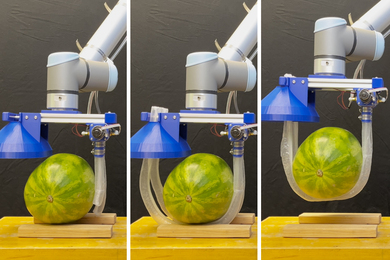In a street fight, there are no rules of engagement. To win, you need to think quickly and do the unconventional. Sanjoy Mahajan, visiting associate professor in the Department of Electrical Engineering, brings this no-holds-barred spirit to his upcoming MITx course, 6.SFMx Street-Fighting Math, which starts April 8 and is open for registration on the edX platform. Mahajan will teach students how to calculate approximations in real-life situations, to arrive at an educated guess when exact answers are not easy to obtain.
Mahajan begins the first class of his residential course by writing on the board, “Rigor leads to rigor mortis.” He believes math should be fun, and criticizes methods that rely on rote memorization to teach math. He says, “Because of rigor mortis, people think I do it right, or I don’t do it," an attitude that intimidates many students. Mahajan likens math to physics experiments. “You investigate it, just like you investigate the world, as a giant laboratory with objects, devices, and patterns.”
One of Mahajan’s major research interests is improving the teaching of math and science by doing away with rote memorization, which he calls “brittle knowledge that doesn’t transfer to any new problem. For instance, in quadratic equations, students have a hard time using ‘y’ as a variable, because they’re always so used to using ‘x’.” He explains that while learning algebra, “[Students] didn’t understand what they were doing. They saw the pattern of using ‘x’ as a pin mark, but didn’t understand its meaning. They only remembered the order of symbols in a formula; they didn’t understand the meaning of what they were doing.”
Applying rigid formulas without considering their consequences can lead to serious mistakes. For example, when asked the answer to "6 x 3", most children give it correctly as 18, because they have memorized multiplication tables. When asked to write a story problem for this equation, the most common example deals with ducks in a pond. Children will typically write a problem that describes six ducks in a pond, joined by three more ducks. When the children ask how many ducks there are in total, they expect the answer to be 18, because they are following a pattern set by the equation. They do not stop to examine the facts, and consider the difference between addition and multiplication. Unfortunately, many children continue this habit of applying formulas without critical thinking throughout their school years.
To disseminate his innovative approach, Mahajan began teaching Street-Fighting Math in 2007 during the Independent Activities Period, a time in January before regular classes begin when MIT students can take enrichment courses. The residential course will be taught this semester during the last seven weeks. The curriculum will be exactly the same in terms of rigor and materials for both residential and MITx students. The only difference is that the residential students will be learning the curriculum a week before the MITx students, to test the materials before they go online.
Street-fighting math will have no lectures, just short videos of Mahajan explaining problem sets, which students will have to work on. The problems will be graded immediately by the computer. Mahajan explains, “The advantage is that students see the answer right away, while they’re still thinking about the problem . . . Lots of research shows that for feedback to be effective, it’s best for it to be immediate.” If the answer is wrong, “Students will have links to help them understand each problem, which will lead them to pieces in the reading (assignments), that will help them understand the problem.”
Along with teaching 6.SFMx, Mahajan will be conducting research on how students learn online, but he is still working on the details. “I’m learning too,” he says. “It’s my first online course.”
Mahajan is looking forward to the edX course, to reaching “people who have a math background, but it’s been wasted.” He wants to “teach if for the whole world”, to generate more enthusiasm for learning math, because it “can help you understand things. It can show you how the pieces of the world are put together.”
To give an actual example of street-fighting math in action, Mahajan tells a story from his teaching days at Cambridge, many years ago. Borders had just opened a new store in Cambridge and was holding a contest. They had a gigantic jar filled with beans, and were offering a prize for guessing the correct number. A group of Mahajan’s students entered the contest and won. They applied Mahajan’s method of breaking down difficult problems into easier ones, by counting the beans in each dimension: height, width, and depth. Then they multiplied these numbers to arrive at an approximate answer. “I call it divide-and-conquer reasoning,” says Mahajan. “It worked for the British to rule India, and it works for problem-solving.”






